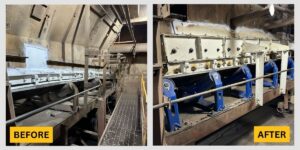Success Story: Improving Silica Dust Control & Material Spillage

Problem Summary
A leading steel producer in the North-Central U.S. was experiencing significant dust and material containment issues at two critical transfer points. Excessive wear in the chutework and skirting systems led to frequent material spillage, causing operational inefficiencies and requiring manual cleanup during downtime.
Furthermore, the plant was experiencing elevated levels of respirable crystalline silica dust, with readings above MSHA’s current allowable exposure limits. This required personnel to wear respirators while working inside the various areas of the facility.
With MSHA’s more stringent silica standards set to take effect in the near future, the plant needed a long-term, engineered solution for MSHA silica compliance and conveyor dust control. This meant reducing dust exposure, controlling spillage, and improving safety and compliance throughout its material handling operations.
Benetech Solution
Key upgrades included a redesigned load zone and containment system that reduced the material drop height, minimizing impact, limiting disturbance, and significantly decreasing airborne dust generation.
New modular skirtboard walls were engineered to handle the heavy material and featured reinforced clamps, B+ Seals, and liner-backed sidewalls for improved containment.
To maintain a consistent sealing surface, Benetech supplied upgraded belt support using Simple Slide Idlers and 2-gang roll-and-guide impact beds. The transfer point was extended to allow more time for dust to settle, while strategically placed spray manifolds, controlled by the BenePak system, targeted airborne dust at its source—an essential step for achieving conveyor dust control and meeting silica compliance goals.
Benetech products included, but were not limited to:
- Extra Heavy Duty MaxZone® Load Zone System — An intensive belt enclosure system with easy-to-access, externally adjusted skirtboards; internal wear liners; dust curtains designed to disrupt air flow streams and prevent dust escaping the enclosure; and rubber skirting.
- BenePak — A self-contained, automated dust suppression unit that uses existing water systems and chemical surfactants to deliver consistent, targeted dust control.
- BT-205W — A highly effective, environmentally friendly dust suppression chemical agent that increases water’s ability to wet dust particles and suppress material emissions, allowing for dust control with less mess and moisture.
- Simple Slide Idlers — Roller frames that quickly slide into place without the need to remove adjacent idlers, resulting in excellent serviceability and improved safety.
- Warrior Impact Beds — Durable steel frames with rubber bars that lie beneath the load zone where abusive impact occurs to cradle the belt and provide stability, and shock absorption to prevent spillage and minimize premature belt wear.
Successful Results
After installation and a few minor adjustments, the plant saw significant improvements across multiple areas. Airborne silica dust levels dropped to within the acceptable range, and the customer reported that the dust readings were consistently lower, therefore supporting MSHA silica compliance well ahead of the upcoming regulatory changes.
Additionally, material spillage at the transfer points was virtually eliminated. Cleanup requirements were greatly reduced, allowing maintenance teams to focus on more critical tasks. Overall, the upgrades improved site safety, reduced labor demands, and enhanced system reliability.
- Enhanced safety and regulatory compliance from consistent air quality improvements
- Decreased spillage and material waste at transfer points
- Reduced labor hours through faster maintenance and improved accessibility
- Minimized risk of system or component degradation with heavy-duty equipment installation
- Achieved long-term MSHA silica compliance and conveyor dust control

